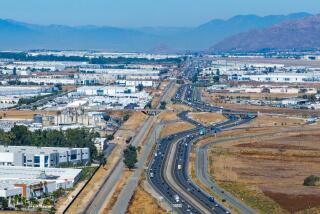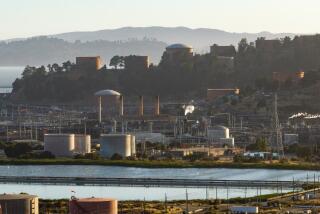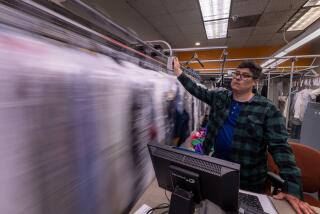City Capitalizes on ‘Rust Belt’ Heritage : Former Factory Buildings in Emeryville Now Humming with Technology Firms
- Share via
EMERYVILLE, Calif. — This East Bay city of 5,000 residents occupies a smaller area than Hermosa Beach (1.2 square miles or 742 acres) but its pro-development attitude and stock of outdated industrial buildings makes it an attractive place for developers in the often hostile Bay Area.
Once thought to be only a good source of used bricks for remodeling projects, those long-vacant industrial buildings on generous sites represent a major source of recyclable real estate for developers like Howard Goldenberg.
A native of Los Angeles who has lived in the Bay Area for 14 years, Goldenberg is head of Goldenberg Associates and is the partner, with Francis Collins of Dream Builders, in the Hollis Street Project.
The new development at 59th and Hollis streets has 185,000 square feet of space carved out of a 1930s-vintage International Harvester truck plant that closed years ago. Its tenants include an upscale restaurant and a computer software firm.
“Emeryville’s pro-development attitude is in strong contrast to the attitude of Berkeley, its next-door neighbor,” Goldenberg said. “Emeryville is committed to quality development, and its highly successful biotech corridor is a result of this commitment.”
Another Emeryville booster is Richard Robbins, founding partner of 10-year-old Wareham Development Co., San Rafael.
In 1979, Wareham built Emeryville’s first live-in artist studio complex in a six-story industrial building at 6221 Hollis St. Since that beginning of an East Bay SoHo--Manhattan trendy loft district--named for its location south of Houston Street--Emeryville has become home to from an estimated 500 to 1,000 live/work artists, according to City Manager John A. Flores.
Wareham is also a major force in the development of the Emeryville/Berkeley/Oakland “Biotech Alley.” More than a dozen biotechnology firms, including Cetus Corp., the second-largest in its field, have made Emeryville their home.
Biotech firms occupy more than 800,000 square feet of space, including Wareham’s Emeryville Research & Development Center, a 135,000-square-foot rehab of a former Shell Oil facility, and Heritage Square, 100,000 square feet of space on 7 acres.
Like Factory Atmosphere
“The idea of working in a converted old factory appeals to a lot of people in the biotech industry,” Robbins said. “They prefer it to being in a suburban research and development park, and Emeryville is right next door to Berkeley, where many of the biotech people live.”
The former Shell facility is fully leased to Chiron Corp.; Cetus Corp., the city’s largest employer with 550 workers; Aquanautics and Ebonex. Heritage Square, a combination of new and existing buildings, is fully leased to UniSoft, the U.S. Postal Service and other tenants.
Robbins and his partners, Mark Scher and Dan Nourse, are also the developers of Aquatic Park, a 300,000-square-foot project in Berkeley’s industrial area, where the second phase is under construction. Tenants include Xoma, Sybase and the California State Automobile Assn.
The downside to all of this growth is traffic congestion, Flores said. The tiny city is home to 30,000 workers during the day, leading to traffic congestion that exceeds that of much its much larger East Bay neighbors. Its location at the entrance of the Bay Bridge adds to the traffic problem.
Traffic in this community, where Interstates 80 and 880 come together, would be relieved by connecting Shellmound Street to Bay Street, providing another through street to the city to supplement Hollis Street and San Pablo Avenue, he said. This project would involve the cooperation of Oakland, where Flores worked until he became city manager last January.
Emeryville is rapidly improving its shopping situation with the addition of the new Powell Street Plaza, a 161,000-square-foot promotional shopping center adjacent to the Powell Street exit of Interstate 880, which will include a new Circuit City electronics store, record and fabric shops and five restaurants.
Like many other developments in Emeryville, the new shopping center is a project of the Martin Co., headed by 32-year-old David Martin.
Seeking Civic Center
Martin is also the developer of Emeryville Market, a $35-million, 200,000-square-foot retail/mixed-use development being created from brick warehouses.
Emeryville is seeking a civic center so that all the city’s workers can be in one place, Flores said.
City offices are scattered around Emeryville, with Flores working out of a high-rise at 2200 Powell St. Three civic center sites are under consideration, including the existing City Hall at Park and Hollis streets, he said.
NEXT WEEK: Foster City saves its “downtown” for last.
More to Read
Inside the business of entertainment
The Wide Shot brings you news, analysis and insights on everything from streaming wars to production — and what it all means for the future.
You may occasionally receive promotional content from the Los Angeles Times.










